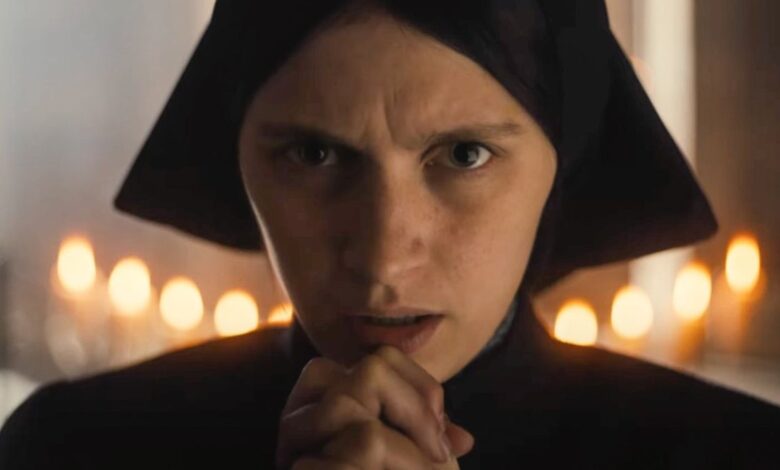‘The First Omen’ Producers Reveal How Horror Movies Are Helping to Save the Theatrical Experience

Since opening earlier this month, Arkasha Stevenson’s “The First Omen,” a scary good prequel to 1976’s “The Omen,” has become something of a cult hit.
It has amassed more than $35 million, with social media dotted with demonically enthusiastic responses (a critic saying that he was seeing the movie for a fourth time was responded to by Mark Millar, the comic book creator behind “Kick-Ass” saying he’d seen it twice). Quentin Tarantino’s New Beverly Cinema, arguably the hippest movie house in all of Los Angeles, screened “The First Omen” as part of a special 35mm presentation.
In an age of endlessly hyped, prepackaged event movies, “The First Omen” seems to be gaining traction as a genuine, word-of-mouth sensation. Not bad for a movie that was meant to go directly to Hulu.
David S. Goyer and Keith Levine know this landscape well. Their production company, Phantom Four, has been responsible for some of the more exciting genre films and television shows from the past few years – including the Apple TV+ science fiction series “Foundation,” the “Hellraiser” remake (which breathed life back into a similarly moribund franchise) and “The Tomorrow War,” an alien invasion epic that was produced by Paramount but wound up on Prime Video.
Since the beginning, “The First Omen” flew under the radar. Until people actually saw it.
“When we were making the film, to a certain extent, the eye of big Disney and Fox, weren’t as focused on the film. And then when we were completing the film and we were showing it to the higher-ups at Fox and Disney, I think everyone said, ‘Oh, wow, this is a real movie. This is better than some of the plays that have happened, with other titles and other studios,’” Goyer told TheWrap. “And everyone at Fox and Disney has just been really impressed with the integrity of the film and the visuals and Arkasha’s vision.”
Still, Goyer admitted, opening a movie like “The First Omen” today is “a challenge.” “Just to be frank, the movie is so much better than I think some of the more jaded members of the audience are thinking, that it will be some of the cash grabs that we’ve seen in the marketplace,” he said.
And he’s right – it’s more sophisticated, both visually and thematically, than you’re probably expecting. It follows a young American novitiate (Nell Tiger Free), who travels to Rome in the early 1970s to become a full-fledged nun. Of course, while there, she uncovers a dark conspiracy to bring about the Antichrist – the same Antichrist that would feature in the beloved Richard Donner movie (and in several sequels of varying quality). It’s a movie that is unafraid to be political and to push buttons, as evidenced by the fact that the movie nearly earned a NC-17 rating.
Thankfully, the theatrical window allows for the film to be discovered; it encourages that word-of-mouth buzz. If it had been released to streaming, it would have drowned in a sea of endless programming.
Goyer and Levine think that, had their wonderful “Hellraiser” redo, been released today, that it probably would have had a theatrical exhibition itself.
“Increasingly, the studios have had more confidence in moving things from streaming,” Goyer explained, citing the rush to streaming during the pandemic and now the swing in the opposite direction.
“In the process of us making it, to David’s point, that theatrical business started to recover. And it was all of a sudden not a Hulu movie and a movie that was going to be in theater,” Levine said. “I think now the theatrical experience is back … horror is one of the things that’s kind of brought it back.”
While it might have seemed daunting to do a new spin on a movie as beloved as “The Omen,” Levine and Goyer were up to the challenge. “We apply what we call the first do-no-harm of storytelling,” Goyer said. “We identify the key core elements of the original, that make ‘The Omen,’ ‘The Omen.’”
They’ll go down the list and then ask themselves, as filmmakers, if they think they can get the studio to buy into it. “If the story we’re crafting veers away from that, then we shouldn’t make it because we’re going against the grain of the DNA,” he said.
They started looking at ’70s cinema – not just the original “Omen,” but things like “Suspiria” and “Don’t Look Now.” They wondered if there could be a societal or political allegory that they could “lay on top” (in Goyer’s words) of the more genre elements. “It does have something to say beyond it just being a horror film,” Goyer added. The team also sought to answer some essential questions from “Omen” lore. “You want to answer the question of where did that baby come from? What about the jackals?” he said.
Levine further noted that there’s nobody better to reinterpret classic material than Goyer. “We always joke that at the time [that Goyer came into the franchise], they had nipples on the costume.”
According to Levine, Phantom Four gets approached with a bunch of titles from various film libraries. And a lot of the time they pass. “There has to be a reason to do it alongside the fact that you can do it,” he said. “That is what guides us.” He points to the “Hellraiser” remake, which didn’t tie directly into the other movies. “We wanted to recalibrate it and bring it back and tell a new story in this different exercise,” Levine said.
Their goal, when making “The First Omen,” was to “make a good movie,” Goyer reiterated, while keeping modern audiences in mind.
“Given when ‘The Omen’ first came out, I don’t know what percentage of the audience wouldn’t have seen the original,” Goyer said. “At least half.”
They are both also quick to give Stevenson full credit for what makes “The First Omen” so special – the look and, perhaps more importantly, the feel of the movie. “There were so many big ideas that she walked in the door with, that were part of her pitch and are in the movie and I think that’s what is really cool about the movie,” Levine said. It was always set in the ’70s with the influences that Goyer listed above, but when Stevenson came in, Levine said, “The deliberateness and artful eye that went into it, that is all her.”
“She had a composed and considered vision. She’s very particular about the framing and composition,” Goyer added. And it shows. This movie is super gorgeous and that vision is one of the things that is often cited by people who go in expecting a run-of-the-mill horror movie but wind up getting something much, much more. Almost like a religious experience, really.
“The First Omen” is in theaters now.






